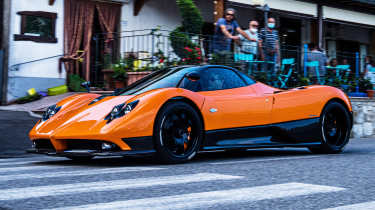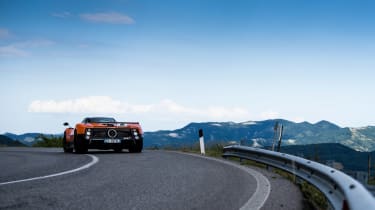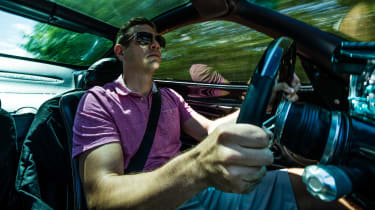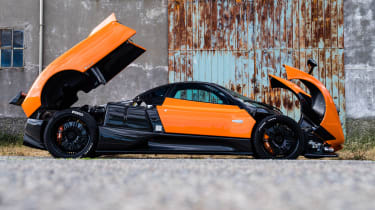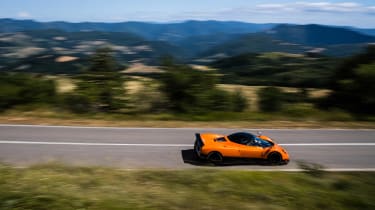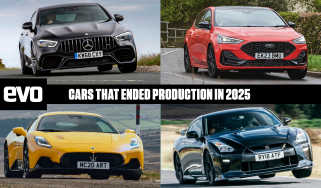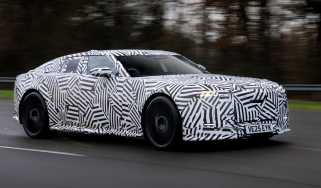Pagani Zonda F review – revisiting an analogue icon
The Pagani Zonda is seen as one of the great analogue supercars, but 23 years on from its launch, does it still have the same impact? We find out behind the wheel of Horacio Pagani’s own Zonda F
Muscle memory is a curious thing. It’s been a while. I haven’t driven a Pagani Zonda F since 2013, when we gathered together the most incredible array of ‘analogue supercars’ including Ferrari F40 and F50, Porsche Carrera GT and, of course, XP5 – the prototype McLaren F1 that hit 240.1mph at Ehra-Lessien on 31 March 1998. Before those surreal few days I guess my last taste of the F would have been back in 2006. Yet I instinctively twist the smooth circular metal grip of the key and hold it there, waiting for the high-pitched starter to spin the 7.3-litre V12 into life. There’s a red start button atop the chunky, cylindrical gearshifter for the six-speed manual ’box, but you don’t need it and my lizard brain remembers to forego the extra step. Just twist, hold, wait a fraction of a second and smile. It’s good to be back.
So much is familiar. The flawless texture of the leather on the seats; the lightweight, hollow action of the gearbox when you practise a few shifts; the feel of the beautifully sculpted clutch pedal on the ball of your foot through padded soles; the tiny amount of squish in the padding of the flat-bottomed Nardi steering wheel. And the view. The view is unforgettable. evo enjoyed plenty of seat time with Zondas back in the early days of Pagani, but I suspect even a snatched ten-minute encounter would still sear these sensations forever. You don’t forget cars like the Zonda F. In fact, memories seem to get stronger as time passes. It seems very strange to say it of a car that I could never dream of owning, but the F feels reassuring, safe and familiar. Like home. Or some fantastical version of it.
More reviews
> Pagani Huayra R goes testing on video: behind the scenes
In many ways Pagani’s first and most revered supercar (hypercars didn’t exist at this point, did they?) is like an impossibly exaggerated, evolved and outrageous dynamic ‘home’ for many of us. It arrived into a unique period in the history of performance cars, benefiting from incredible material technology and engineering possibilities but still with the heart of the driving experience defined by hardware, not by algorithms, active systems and electronics capable of serving up amazingly broad talents with apparent ease. In other words, the car had to be fundamentally right from the ground up and the driver needed finesse and skill to truly exploit the performance. The pinnacle of the era we’ve come to describe as ‘analogue’. It’s an imperfect term, but let’s stick with it for now.
So, there are no modes for me to untangle. No decisions to make before I set off. Take a deep breath, an extra few seconds to commit the scale of this car to memory and understand how to place it on the road, then simply release the heavy clutch pedal and let the AMG V12’s torque push this crazy, lightweight sci-fi sculpture out onto the roads of San Cesario sul Panaro.
The air is fiery hot and thick like treacle and senses are definitely on high alert as the Zonda and I reacquaint ourselves. In truth though, it’s so simple to operate. I’m nervous but only because this Zonda F coupe – 1 of 25, chassis 91 – is Horacio Pagani’s personal car and has recently been through the Rinascimento programme. It’s valued at 7million euros. Rinascimento or ‘Renaissance’ is Pagani’s new restoration service, which sits alongside the Puro certification programme. Think of it as Pagani’s version of the Ferrari Classiche department. We’re not here to discuss values but they give a clue to our mission. The Zonda, any Zonda, has become a supercar icon in the truest sense of the word. It sits in the lineage that runs Miura, Countach, F40, McLaren F1… Extraordinary company to keep, and I’d argue there hasn’t been a supercar or hypercar since to join that most highly prized club. Maybe the T.50 is next. Today we immerse ourselves back into the world of the Zonda and find out if Pagani’s first creation deserves its place amongst the purest of supercar icons.
One thing is immediately obvious. If you think supercars need to be brutal, temperamental, scary and just plain awkward, then the Zonda is not for you. Visibility is superb thanks to the expansive teardrop glass canopy, those long-stemmed, organic and elegant side mirrors are as functional as they are beautiful and the combination of broad-shouldered 594bhp ‘M120’ V12 engine and a polished, effortless ride make for easy progress. Like all carbonfibre-chassis supercars there’s perhaps more road noise than you’d expect, and the weighty clutch and steering – especially if you’re used to modern EPAS or very low effort racks in the likes of, say, a modern Ferrari – give the Zonda a definite physicality, but everything is so wonderfully intuitive and in harmony. Effort and output are measured with a perfect understanding of how to unite driver and car.
It goes without saying that ambling between villages along those peculiar long, straight but very narrow roads that characterise this part of Italy, zipping past half-built and often crumbling farm buildings baked an orangey-pink after years of exposure, and greeted by waves and smiles and the occasional jump for joy is a very fine way to pass the time. Moments of full throttle are fleeting, but the V12’s sonic, almost liquid noise and the way it can pick up the lightweight Zonda (just 1230kg dry, the same as a McLaren 765LT) and hurl it along on a great swell of power that matches the other-worldly aesthetic is simply joyous. The performance isn’t frenzied in the way of something like a Ferrari SF90, but again the F finds a sweet spot between outrageous and exploitable. It’s tantalising. And the mountains in the distance are getting closer…
The F – for Fangio, Horacio’s compatriot, friend and the man who facilitated the fruitful Pagani/Mercedes-AMG relationship – is perhaps the Zonda of Zondas. The original car, the C12, was shown at the Geneva Auto Salon in ’99 and something about its quality and construction marked it out as a car and a company to watch; a project that might not disappear into the ether like so many other bits of fluff often presented at this once most glamorous and speculative of motorshows. But those early C12 models were a taste of what was to come rather than the full dream realised. The 6-litre V12 produced just 389bhp, and whilst the extensive use of carbonfibre made every single horsepower count, it was clear the chassis could handle more power and the concept deserved more drama.
The 7-litre C12-S followed with more of everything, including the staggeringly intricate detailing and craftsmanship that is now so associated with Pagani. Later, it had a capacity hike to 7.3 litres. Then the Zonda F was launched in 2005, at Geneva once again, with new carbonfibre materials for the tub, lighter chromoly for the subframes, a significant power hike thanks to revised intake manifolds and a reworked exhaust, a higher rev limit that necessitated titanium rods, and a host of other changes. Weight was further reduced by the adoption of new carbon-ceramic brakes and lighter suspension arms (coupled with revised suspension geometry), and the F also benefited from new Öhlins dampers.
One thing stayed the same. The only transmission available was a Cima six-speed manual. Subsequent Zondas became more extreme perhaps to the detriment of the original road-focused concept, which was very much in the mould of the McLaren F1, albeit with a more Latin approach to aesthetics. They were also fitted with a single-clutch paddleshift system. It wasn’t perfect over a decade ago and time is particularly cruel to these pre-dual-clutch systems. The F is timeless.
As a nod to our own traditions, we head south towards Firenze but divert up into the mountains en route. Raticosa, Futa… well-worn passes for generations of test drivers for Ferrari, Lamborghini and Maserati, and once witness to the bravery and insanity of the Mille Miglia. The roads are a shade narrow for the Zonda and the route is initially peppered with little villages and buildings that seem to jut into the road, calling for a sharp intake of breath as you squeeze through, dodging Fiat Pandas and maxed-out mopeds. Soon it starts to open out and the villages disperse. The surface is wickedly bumpy, though, damaged by earthquakes in places and, I suspect, just some slightly shonky preparation in others. The Zonda’s construction comes to the fore. It feels so rigid, just like a modern-day hypercar or one of McLaren’s carbonfibre-tubbed supercars, and the benefits in terms of suspension fluency and the accuracy with which the car follows your commands is tangible.
There really is some magic at work here. Combining this kind of material technology with old-school mechanical ingredients, notably the huge naturally aspirated engine and manual ’box, creates a fundamentally intuitive and thrilling whole. It’s characterised by absolute accuracy, crystal-clear feedback, dynamic consistency and a sort of exponentially rewarding driving experience. The F always makes you feel good, of course, but delve beneath the easy-going feel so evident during a brisk, calm drive and start to really push and more and more layers are revealed. Pagani may create cars that could easily pass as pure artwork, but they cut it when you’re focused solely on performance, too. This Zonda F is a proper piece of kit.
Confidence comes quickly and is rooted in the sense of cohesion. It starts with the steering. As I said before, it requires more effort than is required in most new supercars but isn’t needlessly heavy, and the way the weight ebbs and flows as you tackle a corner provides such superb detail. You will have heard steering being described as ‘glassy’ – totally devoid of texture and consistent to the point of numbness. The Zonda’s is the opposite – rich in texture and alive to the surface below it, like a braille map of what’s happening right down at the contact patch. The force builds as the tyre bites, giving you a sense of the car carving into the turn. The rear – so wide and full of that huge engine – follows without a sniff of hesitation and provides reassurance of its own.
With the car settled you can start to dip into the bottomless reserves of the V12. The 7.3-litre AMG unit is such a special engine, and although it doesn’t have the capacity to rev like, say, a Carrera GT, the sheer torque on offer and the way you can exploit it so accurately is a drug all of its own. The rear tyres will take an enormous amount of the rich, fulsome power and in fact the first signs you’re starting to push at the outer edges comes as the steering lightens in your hands and the front just sneaks away from where you’re aiming. Gentle, easily managed understeer might not be the stuff of which dreams are made, but when you start to feel the Zonda F come alive like this it’s pretty special. You’re hustling a big chunk of carbonfibre real estate. And it feels like the most natural thing in the world.
The flow is interrupted harshly and unnecessarily by a traction control system best described as draconian. Horacio Pagani has always been keen that his customers are kept safe and hence a conscious decision was made with the Zonda’s electronics to ensure the car would be restrained early and with force. Understandable. If a supercar had your name on it you’d be keen nobody came to harm in it, too. Unfortunately, this philosophy means that to truly enjoy the car you’re required to completely disable the systems and trust your own instincts and the good work of Loris Bicocchi, the brilliant chassis engineer behind the set-up of the Zonda. Already you know this is not a scary decision. The car has revealed its predictable balance and connected with you on so many levels. Yet, the value and – in this car’s case – the owner’s presence is inescapable. Even so, with a deep breath, I decide it’s the only reasonable course of action.
The next few hours vindicate pressing that little, innocuous button to the left of the gearlever, marked ‘ASR Off’. The character of the F doesn’t markedly change, there’s just unfettered access to all of it talents and a clean pathway between your right foot and the glorious, howling monster of a V12 engine. Now the onset of mild understeer is no longer the end of the road but the opening sequence to a gorgeous interplay of grip and power. The F isn’t a car you powerslide around in, of course, but it can be manipulated and tweaked as much with the throttle as the steering. Driven fast and with care it has the lithe, honed feeling of a Porsche Cayman; get more aggressive and it will give little heart-stopping moments like a GT2 RS, such is its scale and the way the V12 can spin-up the rear tyres if you’re not sensitive to the nuances of the road. But all the time it feels under your control. The F has such depth of ability and a character that you could spend years unlocking and learning to master.
It’s not perfect. Despite the lack of mass the F doesn’t quite have the vertical body control and wheel control of a 2022 supercar. Big undulations create a split second of float on occasion, a rapid series of bumps unsettles the front axle, it patters and rattles where Pagani’s Huayra BC would remain perfectly poised, and there simply isn’t the absolute grip and control that has become so familiar. A new GT3, for example, would get across the ground faster and with less driver effort, that’s for sure. The gearbox, which is so central to this car’s appeal and the connection it creates, isn’t one of the greats, either. The shift is light and a little imprecise. But it doesn’t matter, for anything it lacks in engineered tactility is paid back several times over in how it draws you into the driving experience.
And then you slow down. The little things emerge. The outrageous driving environment isn’t to all tastes but there’s no question that it’s unique, executed to the very highest standards and conjures a sense of occasion like nothing else. The periscope air vents; the way the road is framed by the Group C-inspired front wings; the soft leather straps used to secure the front and rear clamshells that are visible when you open the feathery doors; the curious sense of substance and yet almost weightless action to the thick toggle switches… the Zonda really is a feast for the senses and it’s strangely hypnotic at any speed.
So, it’s understandable that there are probably Zonda owners who never disable the ASR, don’t bother to head for the hills with no plan other than to get nowhere as quickly and noisily as possible. They simply enjoy the gentle sensations of that polished ride, the odd burst of full-blooded acceleration and the sights and scents that combine to make the Zonda F such a wonderful car with which to spend some time. I’m sure they’re very, very happy. Ecstatic, in fact. But they’re missing out. The Zonda F deserves to be let off the leash because it’s only then that you understand just how intriguing, exciting and plain brilliant Pagani’s first ever supercar can be. Unlikely as it might seem, this dazzlingly extroverted, wildly exaggerated and lavishly produced supercar is so much more than an expression of Pagani’s artistry. It’s a driver’s car to its very core. That’s our sort of icon. It’s been a while. Let’s hope the next time is just around the corner.
Pagani Zonda F specs
| Engine | V12, 7291cc |
| Power | 594bhp @ 6150rpm |
| Torque | 560lb ft @ 4000rpm |
| Weight (dry) | 1230kg |
| Power-to-weight (dry) | 491bhp/ton |
| 0-62mph | 3.6sec |
| Top speed | 214mph+ |
| Price when new | £470,000 (2005) |
| Value today | £5,800,000 |

